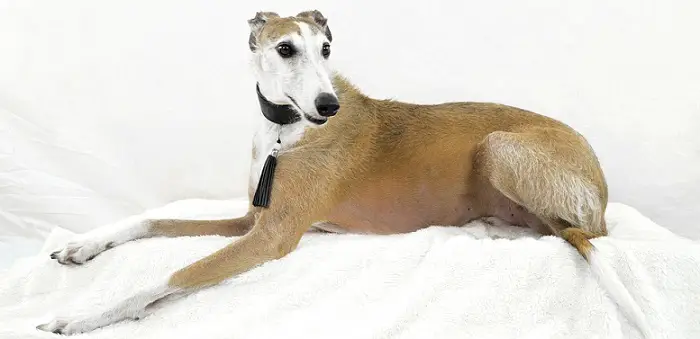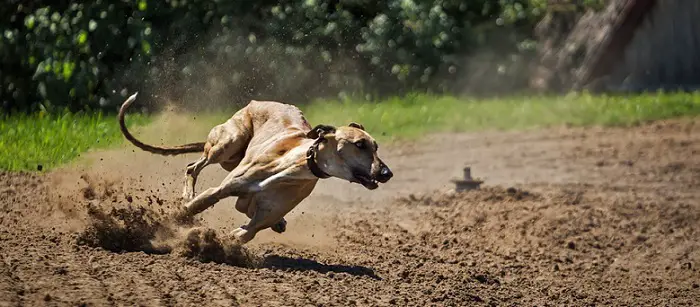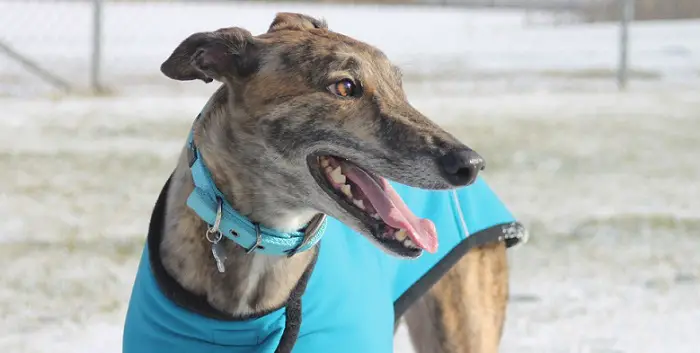Table of Contents
*This post may contain affiliate links. As an Amazon Associate we earn from qualifying purchases.
With their distinctive long head and narrow body, greyhounds are instantly identifiable. Their association with speed and hunting has long been cemented in royal courts and on the racetrack. Originally bred as hunting dogs, they are now cherished by many as gentle pets. The Greyhound is a dog breed that can truly do it all. Learn about the history and temperament of the graceful greyhound dog breed below.

About the Greyhound Dog Breed
Main Characteristics of the Greyhound Dog Breed
Greyhounds are tall and slender, with short coats. Their narrow heads are dolichocephalic, with a skull that is long in comparison to its breadth. They are built for speed, with a slim build and tail, longs legs and muscular rear ends. There are 30 recognized coat forms, including brindle, fawn, and gray. Males are 28-30 inches tall at the withers and weigh anywhere from 60-88 lbs. Females are smaller, at 27-28 inches and 60-75 lbs.
Many believe that a breed designed for racing is high energy, but greyhounds are docile and seldom bark. They’re affectionate and loyal to their owners, while indifferent toward strangers. Greyhounds are generally very intelligent and easy to train. These hounds have a strong prey drive and become easily excited at the sight of potential prey. Racing greyhounds in this excited state are muzzled to prevent dogs from nipping each other on the track or from damaging the lure.
The History of Greyhounds: a Noble Breed
The relationship between dogs and humans has long been a symbiotic one. While some breeds were developed purely for ornamental reasons, the oldest breeds were selected for their abilities to benefit their owners. Among the oldest breeds are sighthounds. They have existed for over 5000 years, and sighthound remains have been found in Egyptian and Sumerian archaeological sights. These dogs were bred for speed and tracking, becoming excellent hunters with a great temperament.
The Greyhound dog breed was developed from these early sighthounds. Greyhounds almost died out during the Middle Ages but were saved by clergymen for the nobility. Their association with nobility continued through the 19th century. Many monarchs, including Queen Elizabeth I, kept greyhounds as pets and hunting dogs. During the rise of industrialization, hunting with dogs became less common, and Greyhounds moved into another sector: racing.
Greyhound Racing

Modern greyhound racing began in England, where the sport rivaled horse racing at one point in time. Early racetracks used a jackrabbit to lure the dogs down the track. In 1912, Owen Patrick Smith perfected the mechanical lure, making jackrabbits unnecessary. This step dramatically increased the popularity of racing, and it was introduced to America in the following decades. Greyhound dog racing and gambling hit its peak in America in the 90s.
The life of a racing dog is not dissimilar to that of a racehorse. Dogs begin racing when they are physically mature, between the ages of 15 and 18 months. They begin training when they are a year old. Training consists of a mix of galloping, walking, and swimming exercises, as well learning to chase lures on a track. The dogs are also massaged and groomed regularly.
Each track can house around 1000 dogs, with up to 20 kennels in operation. Dogs are graded based on performance, and similar grades are raced together. If the grade drops too low, the dog will be retired. Naturally, dogs retire from racing at 3-5 years old. After retirement, the majority of greyhounds are rehomed. Some may be retained for breeding and a small minority may be humanely euthanized.
Finding and Caring for a Greyhound

In recent years, there has been a movement for the adoption of retired racing greyhounds. Charities such as the Retired Greyhound Trust in the UK and the National Greyhound Adoption Program in America have been connecting greyhounds with families for decades. In addition to these rescues, there are many established greyhound breeders with health clearances.
When looking for a new dog, avoid puppy mills and pet shops. Animals from these sources are often sickly or abused, with poor temperaments. The nature of a dog will always vary depending upon hereditary, socialization, and training. If you’re selecting a puppy, try to meet one of the parents to determine if they have a good nature. Look for a healthy, friendly dog and make sure to socialize and train them early.
Despite common belief, a dog from the greyhound breed doesn’t need extra exercise or time to run. Like all dogs, they need daily walks and enjoy time outside. Because of their strong prey drive, it’s recommended to keep them on a leash or in a fenced yard to prevent them from running off chasing a small animal.
In addition to keeping your dog healthy with exercise, feed them twice a day to avoid overeating. Greyhounds can easily become overweight. The greyhound dog breed, like many large dog breeds, is more prone to hip or elbow dysplasia. Other diseases to watch out for include osteosarcoma, hyperthyroidism, and bloat. While the breed is generally healthy, having a good vet is vital. Greyhounds are sensitive to anesthesia and other drugs, so choose a vet who will take this into consideration.
Pros and Cons of Ownership
The greyhound dog breed is renowned for both its elegant look and sweet temperament. Nobility admired them for years, and many worldwide love their greyhounds. Their affectionate, calm nature is a major plus. Greyhounds rarely bark, but are easily trained and highly intelligent. While lounging around all day, they get along well with other people and dogs.
They live longer than most large breeds and can truly become a part of the family. Another positive factor is their short coats, which mean very little grooming. However, there are some important drawbacks to consider. They are large dogs, and may not be good for small apartments. Because greyhounds need to be contained when outside, it would be ideal to have a fenced backyard, though not necessary.
Their strong prey drive could be a problem for households with small pets such as birds, rodents, or even small cats. A greyhound could potentially harm the pet when instinct takes over. With that being said, they aren’t good watchdogs. Look to another breed if you want a guard dog.
Bottom Line
The greyhound dog breed is ancient, elegant, and noble. They have a storied history in palace courts and racetracks. Their popularity is well deserved– greyhounds are both talented athletes and amiable companions. With hundreds of greyhounds available to rescue from racing, why not welcome a gentle giant into your home?
